
Arlington House, The Robert E. Lee Memorial, formerly named the Custis-Lee Mansion, is a Greek revival style mansion located in Arlington, Virginia, United States that was once the home of Confederate Army General Robert E. Lee. It overlooks the Potomac River and the National Mall in Washington, D.C. During the American Civil War, the grounds of the mansion were selected as the site of Arlington National Cemetery, in part to ensure that Lee would never again be able to return to his home. The United States has since designated the mansion as a National Memorial. Although the United States Department of the Army controls Arlington National Cemetery, the National Park Service, a component of the United States Department of the Interior, administers Arlington House.
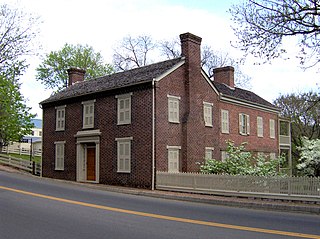
Andrew Johnson National Historic Site is a National Historic Site in Greeneville, Tennessee, maintained by the National Park Service. It was established to honor Andrew Johnson, the 17th President of the United States, who became president after Abraham Lincoln was assassinated. The site includes two of Johnson's homes, his tailor shop, and his grave site within the Andrew Johnson National Cemetery.
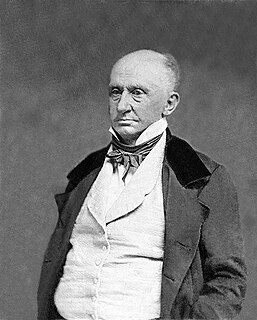
George Washington Parke Custis was an American plantation owner, antiquarian, author, and playwright. The grandson of Martha Washington and step-grandson and adopted son of George Washington, he and his sister Eleanor grew up at Mount Vernon and in the Washington presidential households.
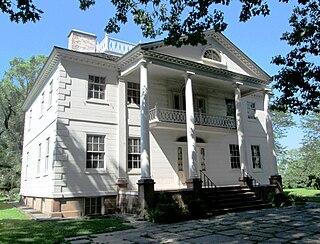
The Morris–Jumel Mansion or Morris House is a Federal style museum home in northern Manhattan with mid-eighteenth century roots. It was built in 1765 by Roger Morris, a British military officer, and served as a headquarters for both sides in the American Revolution.

Tudor Place is a Federal-style mansion in Washington, D.C. that was originally the home of Thomas Peter and his wife, Martha Parke Custis Peter, a granddaughter of Martha Washington. Step-grandfather George Washington left her the $8,000 in his will that was used to purchase the property in 1805. The property, comprising one city block on the crest of Georgetown Heights, had an excellent view of the Potomac River.

Liberty Hall is a historic house museum at 218 Wilkinson Street in Frankfort, Kentucky. Built 1796-1800 by American statesman John Brown, it was designated in 1971 as a U.S. National Historic Landmark for its association with Brown and its fine Federal-style architecture.

Lower Brandon Plantation is located on the south shore of the James River in present-day Prince George County, Virginia.

Fort Hill, also known as the John C. Calhoun Mansion and Library, is a National Historic Landmark on the Clemson University campus in Clemson, South Carolina. The house is significant as the home of John C. Calhoun, the 7th Vice President of the United States, from 1825 to 1850. It is now a museum and library maintained in his memory.

Magoffin Home is located in El Paso, Texas. It was placed on the National Register of Historic Places in 1971. The surrounding area was declared the Magoffin Historic District on February 19, 1985. The home is now known as the Magoffin Home State Historic Site under the authority of the Texas Historical Commission.
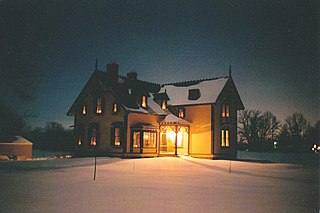
The Nicholson–Rand House is a historic house located in Decatur Township, Marion County, Indiana, in Indianapolis. It was moved by the Historic Landmarks Foundation of Indiana (HLFI) half a mile south to save it from being demolished in 1997 and added to the National Register of Historic Places in 2003. The house is an example of the Gothic Revival style of American architecture typified by Alexander Jackson Davis and Andrew Jackson Downing in the mid-19th century.

The Fite-Williams-Ligon House is a historic mansion in Carthage, Tennessee in the United States.

The Anderson-Coward House, also known as Justine's Restaurant, is a historic mansion in Memphis, Tennessee, USA.

Ashcrest Farm is a historic mansion in Hendersonville, Tennessee, U.S.. Designed in the Classical Revival architectural style, it was built by slaves before the American Civil War and black laborers after the war. The land has been owned by the same family since 1810. Today, it is a horse farm.
Dozier Farm, also known as Cliffview Farm, is a historic mansion in Nashville, Tennessee, U.S..
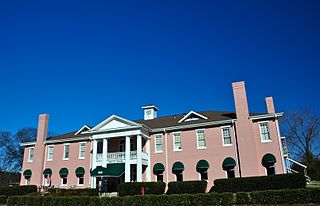
The Austin Hewitt Home is a historic mansion in Pulaski, Tennessee, U.S.. It was home to the Pulaski Female Academy from 1832 to 1852. It was the private residence of the Childers, Ragsdale and Beasley families until 1924, when it became a home for indigent homeless women endowed by philanthropist Austin Hewitt. It is now a retirement home.
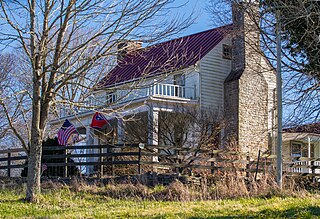
The Prewitt-Amis-Finney House, also known as Turnhill Farm, is a historic three-story house in Culleoka, Tennessee, U.S.. Built for the slaveholding Prewett family in 1810, it was established as a mule farm. It is located a few miles away from Columbia, and it overlooks Fountain Creek.
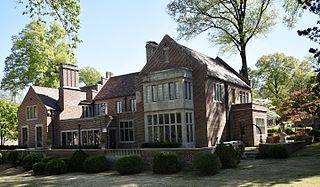
The Robert M. Carrier House, also known as the Matthews House, is a historic house in Memphis, Tennessee, U.S.. It was built in 1926 for Robert M. Carrier and his wife. In 1974, it was purchased by William S. Matthews, Jr. It was designed in the Jacobean Revival architectural style by Bryant Fleming, a Professor of Architecture at Cornell University. It has been listed on the National Register of Historic Places since May 27, 1980.

The Andrew J. Cheney House is a historic house on a former plantation in Marietta, Georgia, U.S.. Built in the Antebellum Era, it was used by Union General William Tecumseh Sherman during the American Civil War, and it was the private residence of a state representative after the war. It is listed on the National Register of Historic Places.

The Isaac Conger House is a historic house in Fayetteville, Tennessee. It was built in 1808 for the Conger family. It is listed on the National Register of Historic Places.

The Silas W. Kendall House was built as a single-family home, located at 7540 Stadium Drive in Oshtemo Township, near Kalamazoo, Michigan. It was listed on the National Register of Historic Places in 1990. As of 2019, it houses an architectural business.




















